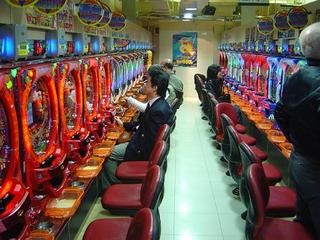Introduction:
As a follow-up to our recent investigation into the pachinko industry, we thought it would be interesting to get the thoughts and opinions of those who hold the greatest stake in Pachinko industry trends – the average Japanese consumer.
With this in mind, we recruited a group of average Japanese consumers and asked them for their personal thoughts and attitudes toward pachinko.
Respondents:
To gain a realistic image of Pachinko’s image in the mind of the average Japanese consumer, we did not want to focus specifically on hard-core pachinko players. Rather, respondents were segmented into three primary categories based on pachinko experience:
1. Pachinko experienced adopters: those who had prior experience with pachinko and continued to play after initial exposure.
2. Pachinko experienced non-adopters: those who had prior experience with pachinko prior to the research but did not continue to play.
3. Pachinko naïve: those who had no experience with pachinko prior to the research
Non-adopters and pachinko-naïve consumers were asked to visit a pachinko parlor and personally try playing pachinko prior to the interview (time and pachinko budget were left up to the respondent).
Age and gender were also thought to play a significant role in consumer impressions of pachinko, thus, we were careful to include a normal distribution across gender, age groups, and pachinko experienced adopters/ non-adopters and naïve respondents.
The following is a brief summary of the study results.
Section 1: Background (Experience)
How did you start playing pachinko?
Most respondents who had any experience with pachinko were initially invited to pachinko parlors by either friends or family. No respondents indicated that they happened into a Pachinko parlor by themselves, or were influenced to try it through any influence other than personal introduction.
Social elements are extremely important in initial introduction/ adoption of Pachinko. Conversely, current advertising and promotional tools are not effective in encouraging new Pachinko trial by pachinko naïve consumers.
For those who do not currently play, why not?
Pachinko experienced non-adopters:
Among pachinko non-adopters, the reasons given for their ultimate lack of interest had nothing to do with the noisy smoke-filled atmosphere, financial issues, or preconceptions regarding the Pachinko industry and gambling in general. Rather, those who did not find pachinko an attractive past-time alternative were primarily turned off by pachinko’s “antisocial” nature, requiring the player to focus solely on the machine. Such respondents were more inclined to frequent the horse races or mahjong parlors which involve much more human interaction. Cost factors were also found to play a significant role, as respondents found they could enjoy a whole day at the race track for less than they would be likely to spend in an hour on pachinko.
Pachinko naïve:
“Pachinko naïve” respondents likewise indicated that social elements prevented them from considering Pachinko. The constant media barrage associating Pachinko with delinquency, petty crime, organized crime, money laundering, addiction, and conspiracy theories regarding financing ties with North Korea etc. combined with the lack of effective promotional or public relations campaigns result in a strong negative impressions as well as a fear of being associated with pachinko.

Interestingly enough, the same respondents who indicated they or those around them had negative impressions of Pachinko based on its “gambling” categorization, did not indicate the same reticence toward casino gambling. The logic being that, casinos are more about the glamourous experience than actual gambling.
While pachinko experienced non-adopters and pachinko naïve respondents differed in their sensitivity to the largely negative image of pachinko in society, respondents in both categories indicated that their image of the typical pachinko player (middle-aged male, either blue-collar laborer or “salaryman” office worker with limited intellect) was not an image they aspired to. This was noted to play a role in their decision to either not adopt the past time or avoid pachinko all together.
What did you find enjoyable about pachinko?
Pachinko experienced adopters:
Those who continued to play pachinko after their initial exposure expressed that it was an “oasis,” “a place to escape from reality.” Unlike the experienced non-adopters, pachinko regulars find most attractive the solitary concentration that pachinko provides for. Players focus on the movement of the pachinko palls, the pins in the machine. Everything else is drowned out by the hypnotic flashing lights, digitized bells and musical sequences blaring from all the machines, and stagnant clouds of smoke. “When I am playing [pachinko], I just focus on the pachinko ball movement in the machine. Everything else just fades away,” remarked one experienced respondent.
How often did you play at the height of your pachinko playing?
Pachinko experienced adopters:
Many regular players indicated that they visited the pachinko parlor on a daily basis during the height of their hobby, spending an average of 3000 yen each time over sessions lasting roughly approximately 4 hours. Some respondents indicated that when they had enough cash for either lunch or pachinko, they would often go hungry to support their hobby.
On what occasions would you go to pachinko?
While many regular players responded that they would go whenever they had down time (between business meetings or family obligations), serious players were found to take the reverse approach during the height of their hobby, with pachinko taking a position of prominence in their daily routines.
Did you go by yourself or with friends/ family?
Regular players were initially introduced to pachinko by friends or family, however once they became serious players they tended to take a more solitary approach to their hobby.
This is fairly intuitive in light of the individual nature of pachinko play itself, as well as the tendency for pachinko to attract individuals who relax by involving themselves in solitary pursuits rather than through social interaction.
What made you stop? Increasing financial burden? Health concerns?
Pachinko experienced adopters:
Among Pachinko experienced respondents who ultimately abandoned the past-time in many cases indicated that their decision to stop playing had more to do with lifestyle changes than issues within the pachinko industry itself. Many who had played while living with their family had no financial obligations or responsibilities, however once they began living on their own they no longer had the financial flexibility or free time required for serious playing.
Macroeconomic issues (the collapse of the bubble economy) were also found to limit recreational budgets. This in concert with new Pachinko machines that required a higher investment for the same period of time caused players to rethink their past-time choices.
While pachinko players are indeed captured by the “thrill” associated with gambling, they were found to generally not play specifically for money or prizes, but rather for the experience itself, similar to “game center” arcade games. Thus, as pachinko continues to follow a “high-risk, high-return” trend, the industry inadvertently isolates recreational players.
No respondents indicated that health concerns (physical or otherwise) played a role in their abandonment of pachinko.
Section 2: Pachinko Image
What is your image of Pachinko?
As expected, the image of the Pachinko industry as operating in something of a grey zone (questionable legality of gambling business model, heavy involvement of “Zainichi” Japanese-born Koreans, as well as impact on other social problems) came up almost universally when respondents were asked about their overall impressions. However, while respondents did have the impression of pachinko as having a rather questionable social presence, this was not found to be a strong deterrent in and of itself. Some respondents even indicated that this questionable social status added to the “thrill” of the game.
While the pachinko “grey zone” did not have a direct impact on respondent interest, the secondary social stigma was found to have an impact on initial adoption, particularly among female respondents.
How has it changed over the years?
Those with extensive pachinko experience noted dramatic changes in the pachinko machines, from mechanical to digital. Many of those who had started with mechanical machines expressed a preference for the traditional style, feeling that the new digital machines seemed “boring, fake and hard to understand.” Older, experiences players are also much less attracted to “theme” machines such as those featuring AKB48’s Watanabe Mayu, or images from the popular anime series Rupan Sansei 「ルパン三世」。
Modern pachinko machines were also felt to “eat money,” in the sense that the high-risk high-return format. Whereas former regulars thought of playing pachinko in much the same sense as they would spending time at a café, the significant investment required for even a short time at the machines has detracted from the relaxed experience that attracted them in the past. Furthermore, in isolating recreational players, the current regular customer base is perceived to have shifted to more “professional,” serious, compulsive gamblers.
Did you feel you had to hide your pachinko playing from friends and family? Did image concerns prevent you from starting to play?
Pachinko experienced adopters/ non-adopters:
Pachinko experienced respondents indicated that, while they may not be inclined to proactively declare their preoccupation with pachinko, at the same time they felt no strong reluctance to reveal their hobby to friends and family, or any fear as to how that knowledge may affect their image.
Pachinko naïve:
As opposed to respondents with previous pachinko experience, those who had never experienced pachinko (until this study) expressed strong reservations regarding the perceived stigma surrounding pachinko, stating that not only would they not want their peers to think they had been playing pachinko, but that this social pressure was a significant factor in their abstaining from the past-time.
※ While pachinko naïve and pachinko experienced respondents differed a great deal on their level of concern regarding pachinko player image issues, both pachinko naïve and pachinko experienced respondents indicated they would be reluctant to reveal their hobby to a significant other or potential love interest.
Pachinko is not perceived as conducive to a healthy social life, however it is felt to provide a haven for those seeking an escape from social pressures and social interaction.
Section 3: Recent Pachinko Experience
What stood out to you?
Pachinko Naïve:
Those who had never set foot in a pachinko parlor before this study found the facility to be much cleaner than they had imagined. While there were players smoking in the pachinko hall, the anticipated billowing clouds of stagnant smoke were absent. Pachinko employees were on hand to provide guidance for beginners, and offer advice regarding the more popular machines (apparently Rupan Sansei 「ルパン三世」(anime series) themed machines are hot right now). There was also a significant female customer presence, which conflicted with initial images of the male dominant clientele.
Pachinko experienced adopters and non-adopters:
Those who had been serious players but had distanced themselves from pachinko in recent years found the intensity of the noise in pachinko parlors to have grown exponentially. While volume was also a factor, the diversity of pachinko machines meant that each had a different tune, further contributing to the overall noise. Until recently, there was less variety and machines had been loosely categorized, thus while the volume was loud, the music tended to flow in unison. Pachinko noise is not perceived to be a deterrent by itself, rather it serves an important purpose in the sense that it further blots out reality, effectively allowing the player to focus exclusively on the pachinko play. However, once the noise passes a certain point, it is felt to become a distraction.
Space between pachinko machines, while still insufficient, was found to have increased. The overall atmosphere was cleaner and less smoky. New amenities such as a ladies powder room etc. were observed as well. While there were parlor-specific differences in terms of customer demographics, generally the customer base was found to be a more uniform “middle-aged working-class male” demographic. There were also fewer customers than in previous years.
Section 4: Pachinko and Casino
How do casinos compare to pachinko parlors? Will availability of casino gambling impact your attitude/ actions toward pachinko?
While the majority of pachinko players to not pursue their hobby with the overt goal of making money, rather approaching their pachinko habit in much the same way middle school kids approach arcade games (an escape from reality), pachinko’s public image is that of illicit gambling catering to a “Wakaba – Onecup” working class clientele.
Conversely (and counterintuitively), gambling represents a very small component of the overall casino image. Rather, “casino” brings to mind images of luxurious resorts, elegant parties, limousines and dress codes. While gambling certainly goes on, the gambling takes on more of a “window-dressing” role, the backdrop for social events featuring an “Ocean’s 11” style elite who doesn’t worry about money.
Thus, while both casino gambling and pachinko can be categorized as gambling, they occupy very different positions, representing virtually polar opposite lifestyles to the consumer. As such, there is a minimal chance of any direct impact, positive or negative, on the pachinko industry should casino gambling be introduced to Japan.
Furthermore, as noted earlier, the pachinko “grey zone” itself does not represent a significant deterrent to pachinko play, and in fact adds to the “thrill” among some customers, thus the formal legalization of gambling is unlikely to improve the image of pachinko in any economically meaningful way (more significant, perhaps, would be the tax implications should the formal classification of pachinko change from “amusement” to “gaming”).
Section 5: Suggestions for the Pachinko Industry
What would you like to see that is not yet available?
Respondents were surprisingly forthcoming with suggestions and requests for the pachinko industry.
Many respondents indicated that, while pachinko parlors appear to be widening the space between pachinko machines, they would like more “personal space” around the machines. Along the same lines, they would like to see dividers or even small cubicle spaces for players (in the spirit of the famous individual spaces at Ichiran 「一蘭」Ramen restaurant chain, or the rest spaces at manga cafes).
Why not have headsets? One pachinko naïve respondent suggested that, as a solution to the overwhelming pachinko noise, each machine be equipped with its own headset.
While there were suggestions for an “upscale” spin-off brand that could be inconspicuously included in shopping malls and similar locations, most respondents felt that any “up-scaling” of pachinko would run counter to its’ humble roots as the working class past-time, as well as the strong imagery that the word “pachinko” itself conjures up in the minds of Japanese consumers.
While an upscale “suit and tie” pachinko was felt to conflict with pachinko’s working class roots, respondents noted that a pachinko “experience” may be conducive to a more social atmosphere, in much the same sense that casinos are a component of the resort experience. This format may provide for a “family friendly” environment, as well as a more inviting atmosphere for female customers.
On the other hand, respondents also felt that the pachinko “grey area” could be exploited in advertising campaigns, emphasizing the pachinko experience as an adventure tantamount to proving ones masculinity.
Summary
The pachinko industry is currently in a precarious position. While loyal customers moving away from pachinko can be attributed in part to macroeconomic conditions and personal lifestyle/ life-stage changes, industry trends continue to isolate significant customer groups, while failing to encourage new adoption. However, our consumer interviews reveal that there are multiple avenues available to pachinko industry operators to segment markets and reorient their value proposition to meet the needs of each consumer segment. The “pachinko” brand carries a strong image reinforced over the last half century, thus an attempt at a 180 degree reorientation from casual past-time to up-scale special occasion would likely fail miserably. However, adaptations designed to meet the changing and increasingly diverse needs of consumers while reinforcing the pachinko image and market position could make all the difference to the floundering pachinko industry. Meeting the needs of today’s Japanese consumers, however, will require a little more than AKB.
【ご意見ご感想がございましたら、こちらのメールアドレスまでご連絡ください。: goiken@sugataresearch.com】





